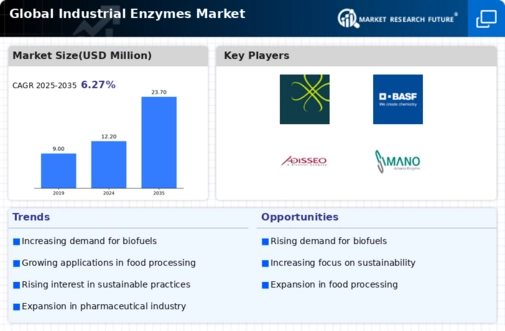Market Growth Projections
The Global Industrial Enzymes Industry is poised for substantial growth, with projections indicating a rise from 12.2 USD Billion in 2024 to 23.7 USD Billion by 2035. This growth is underpinned by a compound annual growth rate of 6.27% from 2025 to 2035. Various factors contribute to this upward trend, including increasing demand across multiple sectors such as food and beverage, biofuels, and pharmaceuticals. The continuous innovation in enzyme technology and the expanding range of applications further enhance the market's potential. These projections highlight the dynamic nature of the industrial enzymes sector and its capacity to adapt to evolving market demands.
Rising Demand for Biofuels
The Global Industrial Enzymes Industry experiences a surge in demand for biofuels, driven by the need for sustainable energy sources. Enzymes play a crucial role in the conversion of biomass into biofuels, enhancing efficiency and reducing costs. As governments worldwide implement policies to promote renewable energy, the market for industrial enzymes is projected to grow significantly. In 2024, the market is valued at 12.2 USD Billion, with expectations to reach 23.7 USD Billion by 2035. This growth reflects a compound annual growth rate of 6.27% from 2025 to 2035, indicating a robust future for enzyme applications in biofuel production.
Advancements in Biotechnology
Advancements in biotechnology contribute to the expansion of the Global Industrial Enzymes Industry. Innovations in enzyme engineering and production techniques enhance the performance and specificity of enzymes, making them more effective in various industrial applications. For instance, the development of genetically modified microorganisms allows for the production of enzymes that can operate under extreme conditions, thereby broadening their applicability. This trend is likely to drive market growth as industries seek more efficient and cost-effective solutions. The increasing focus on research and development in biotechnology suggests a promising trajectory for the industrial enzymes sector.
Growing Food and Beverage Sector
The Global Industrial Enzymes Industry benefits from the growing food and beverage sector, where enzymes are integral to various processes such as brewing, baking, and dairy production. Enzymes enhance product quality, improve yield, and reduce processing times, making them indispensable in food manufacturing. As consumer preferences shift towards healthier and more natural products, the demand for enzyme-based solutions is likely to increase. This trend is reflected in the market's projected growth, with a valuation of 12.2 USD Billion in 2024 and an anticipated rise to 23.7 USD Billion by 2035, driven by the food industry's evolving needs.
Emerging Applications in Pharmaceuticals
Emerging applications in pharmaceuticals are reshaping the Global Industrial Enzymes Industry. Enzymes are increasingly utilized in drug formulation, synthesis, and production processes, enhancing efficacy and reducing side effects. The pharmaceutical sector's demand for biocatalysts is on the rise, driven by the need for more efficient and sustainable manufacturing methods. As the industry evolves, the integration of enzymes into pharmaceutical processes is likely to expand, contributing to market growth. The anticipated increase in market value from 12.2 USD Billion in 2024 to 23.7 USD Billion by 2035 reflects the potential of enzymes in addressing the pharmaceutical industry's challenges.
Environmental Regulations and Sustainability
Environmental regulations and a growing emphasis on sustainability are pivotal drivers of the Global Industrial Enzymes Industry. Industries are increasingly adopting enzyme-based processes to minimize waste and reduce environmental impact. Enzymes facilitate greener production methods, aligning with regulatory requirements and consumer expectations for sustainable practices. This shift is particularly evident in sectors such as textiles and detergents, where enzymes replace harsh chemicals, leading to eco-friendly alternatives. The market's growth trajectory, from 12.2 USD Billion in 2024 to 23.7 USD Billion by 2035, underscores the importance of sustainability in shaping the future of industrial enzymes.

















Leave a Comment